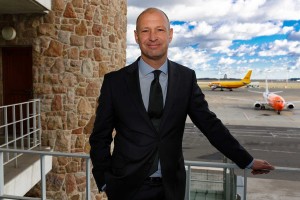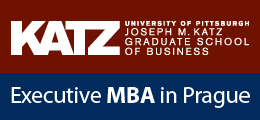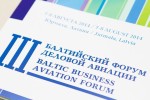Budapest; best Eastern European airport
 Budapest International Airport was named ‘Best Airport – Eastern Europe’ at the latest Skytrax World Airport Awards ceremony. Receiving this esteemed Award is an accomplishment and testimony to ongoing developments as well as a commitment to continuously delivering best-practices in all areas. The results of the Skytrax Awards are based on the world’s largest customer satisfaction survey, completed by airport passengers from over 160 countries. Evaluating airports across 39 services and product features, from arrival to departure, passengers are expected to make their own, real, honest choices. Budapest Airport’s growing popularity is evident. We sat down with Jost Lammers, Chief Executive Officer to find out more about Budapest Ferenc Liszt airport’s current success and its future vision.
Budapest International Airport was named ‘Best Airport – Eastern Europe’ at the latest Skytrax World Airport Awards ceremony. Receiving this esteemed Award is an accomplishment and testimony to ongoing developments as well as a commitment to continuously delivering best-practices in all areas. The results of the Skytrax Awards are based on the world’s largest customer satisfaction survey, completed by airport passengers from over 160 countries. Evaluating airports across 39 services and product features, from arrival to departure, passengers are expected to make their own, real, honest choices. Budapest Airport’s growing popularity is evident. We sat down with Jost Lammers, Chief Executive Officer to find out more about Budapest Ferenc Liszt airport’s current success and its future vision.
“It was not a first-time achievement; we have already won the Award in 2014. This is in addition to many other awards we have collected from architecture awards to best marketing awards and even the best refinancing of the year! I put these achievements down to one basic factor: teamwork! We place quality, service and a can-do attitude at the forefront of all of our daily work. We include quality measures in management and front line performance target schemes. In addition to having a great location and a recovering economy, we have been able to secure more passenger and cargo carriers than many nearby competitors. Of course our infrastructure and capacity puts us at the top of many aviation company‘s lists.”
Last year, Jost Lammers was named “Entrepreneur of the Year” by the Hungarian National Association of Entrepreneurs and Employers. He is a member of the Curatoium of the Corvinus University of Budapest. His previous experiences include Managing Director of Flughafen Dusseldorf Ground Handling GmbH, Senior-Asset Manager at Athens Airports. The latter background experiences may have helped to meet any international challenges in Hungary.
“It is very much the cross cultural experience and the specific airport know-how that I was able to gather over the years at various airports and in various functions. It helped me to quickly get settled in Budapest and in my role at the airport. It was very helpful to have a wide operational knowledge from my previous positions in order to develop BUD Airport in all areas. I could do it in a stable manner from a very much operations and technical driven organization to a service oriented, customer and commercial focused one.”
Throughout his career Jost Lammers had to deal with totally different languages; Hungarian, German, Greek and of course English.
“Hungarian is a unique language and Hungarians are very proud of their identity; so are our Hungarian passengers. From a business perspective, English is the International standard and that is our formal internal business language as it transcends most borders. Of course, Hungarian is used when we deal with authorities as local laws are governed by the Republic of Hungary. Therefore the corresponding text is in Hungarian which is why we employ two full time translators in our offices to help us assist in such matters. As for myself, I would call myself as an intermediate Hungarian speaker at best!”
The accomplishments of Budapest Airport are admirable and commendable. Spirits and expectations for 2015 are high after last year’s most successful year in history. Airports are no longer just transportation hubs. They have to become service centers. What is in the pipeline beyond 2015?
“It is important to reflect on the past to help direct the future. We have had a remarkable turnaround in the last three years, particularly culminating in record passenger numbers in 2014. So far, in 2015, we appear to be on track to exceed our own expectations of 9.65 million and even pushing the 10 million mark. This year’s first quarter performance is already 12% ahead of 2014! Of course, rapid growth means that we must bring forward some of our master plan developments. These are subject to necessary board and permit approvals. They will include a new airside pier offering more gates than today, an extension of the landside check in and security capacity with the introduction of Terminal 2C, a real airport hotel, new and enlarged cargo facilities, car park expansions and of course other smaller demand led projects. In terms of runway and apron capacity, our present infrastructure is more than capable of handling much more aircraft movements. Although our passenger numbers are booming, we are still some 30% behind the movements we had in 2011 when Malev still existed.”
Budapest International Airport is now eight years under the leadership of Jost Lammers. Many things have developed and every year has shown positive milestones. Teambuilding and managerial freedom may be the recipe for success.
“No doubt that the team spirit is one of the most important drivers for our success. We had the freedom to build up a strong international team on the executive level but also to continuously develop and recruit excellent senior and middle managers. We take pride in regularly identifying successors for key positions internally. This is extremely motivating for a team of ‘young’ leaders. I believe that the other key factors are the trust and confidence given by our shareholders and the absence of major political influence. This helped us to always focus on doing reasonable things.”
Budapest Airport is run by a consortium of private investors from Germany, Canada, and Singapore. It is unusual in Eastern Europe if an airport is not run by a public entity. In Budapest, the private involvement did contribute to the success and brought advantages to the development of the airport.
“It was even more unusual when Budapest became privatized. However, more and more airports in the region are becoming either fully privatized or a mixture of public/private partnerships. In fact most recently, FRAPORT acquired the management rights to operate. Ljubljana airport in Slovenia and other airports in Poland and Romania are also moving in to private hands. In our case, there is no doubt in my mind that being in private hands enabled us to make agile decisions. At the same time it is imperative to consult with stakeholders in the public sector. Our obligations are also to our board of directors, airlines, passengers, suppliers and of course staff. In many emerging markets, there appears to be a growing appetite by countries in Europe to privatize none core assets. Operating an airport for example is hugely labor and cost intensive. A private international aviation company like our majority shareholder Avi Alliance has excellent international aviation expertise and it will help the airport continue to move forward.”
BUD (LHBP) has a General Aviation terminal. In recent times it has been renovated to provide a much better surrounding for its users. It has a great design, excellent catering and all the amenities needed to serve GA clients. The terminal is operated by Celibi Hungary which provides most handling services. However, other handling providers can also serve their clients’ needs at the terminal. The traffic through the terminal is prone to certain peaks around events such as the Red Bull Air Race or the Hungarian Formula One Grand Prix. Business Aviation is vital to the airport although it represents five percent of all movements.
“This segment is very important for our future growth. The improving economy, combined with increasing foreign investment is leading to a compound growth expectation of around 5-6% each year in General Aviation which is in line with our midterm passenger traffic number forecasts. We promote the GA capabilities at every opportunity to ensure that potential clients are able to select the airport for their GA needs. My advice is to come and see for yourself how developed BUD is and what it can offer.”
One thing is very certain. Hungary’s well documented and forecasted potential is now beginning to bear fruit with exceptional tourism numbers, ever improving infrastructure and a sympathetic aviation environment.
Publishing or copying the content of AVIATION Times without a written electronic permission is strictly forbidden. If you have any information, tips, videos, photos or your press releases for us contact us at news@aviation-times.aero.
AVIATION TIMES © Copyright 2012 - 2025







